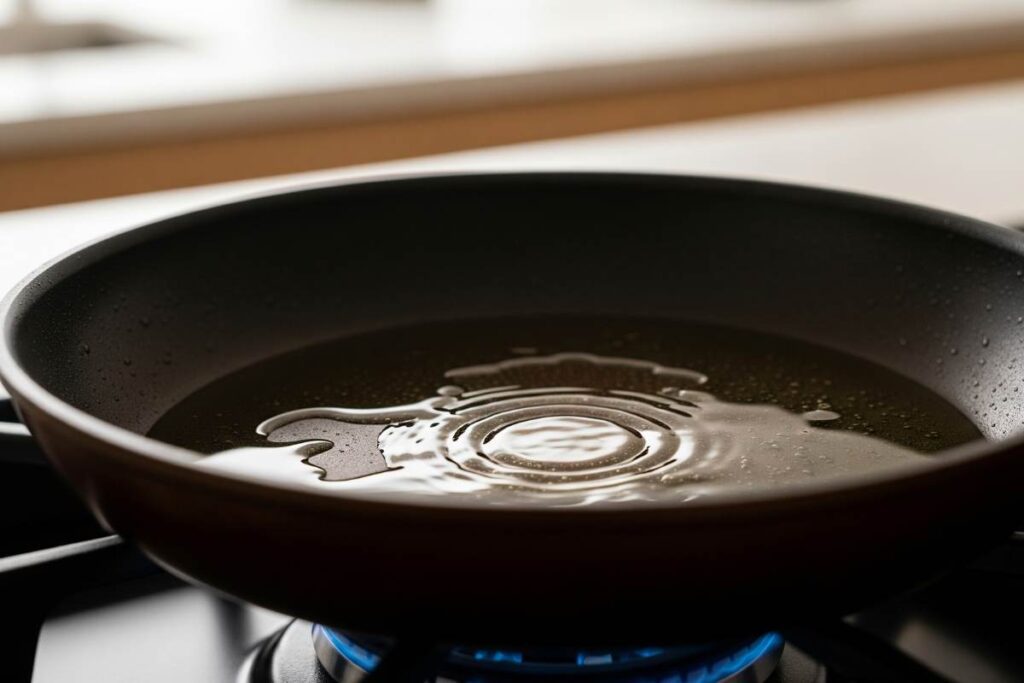Ready to Take Your Cooking to the Next Level?
You know how it goes, one minute you’re sautéing a few onions, the next, you’re dodging clouds of burnt oil smoke. Funny thing is, it happens to the best of us. So, what’s the fix? It starts with understanding your cooking oil. Specifically, the smoke point, that magical threshold no kitchen should ignore.
What’s a Smoke Point Anyway?
Alright, before we dive into all the oils and their secrets, let’s get straight about the basics:
- Smoke Point: The temperature at which oil starts to smoke, break down, and release substances that might not be so great for your health (or your dinner’s flavor).
- Why does it matter? Well, heated past this point, oils break down into free radicals and acrolein, a chemical that gives burnt food its distinctive, not-so-pleasant aroma. Yep, not ideal.
But there’s more… Choosing an oil with the right smoke point doesn’t just keep your kitchen air clear; it means better flavor, texture, and nutrition. Let’s crack this open.
Quick Hits: Benefits of High Smoke Point Oils

- Safer high-temperature cooking: Think deep-frying, wok stir-frying, searing steaks, the works.
- Cleaner taste: No burnt, bitter notes sneaking in.
- Versatility in recipes: From Mediterranean to Asian cuisine, these oils fit right in.
- Less breakdown of healthy fats: Quality is maintained for heart health.
- Longer shelf-life: Many high smoke point oils stick around longer in your pantry.
Breaking Down the Science (If You’re Interested)
Different oils contain different fatty acids. The more refined an oil, funny enough, the higher its smoke point tends to be. Why? Refining strips away impurities that cause smoke, those tiny bits left over from the seeds, nuts, or fruits.
Here’s the kicker: Not all “refined” oils are created equal. You need to peek at the label, maybe ask a store clerk, and double-check what’s inside.
The Heavy Hitters: Types of High Smoke Point Oils
Alright, here comes the real nuts and bolts. Let’s roll through the line-up of kitchen MVPs.
Avocado Oil
Smoke Point: 520°F (271°C)
- Good for: searing, grilling, deep-frying, salad dressings.
- Profile: Mild, buttery flavor. Packed with monounsaturated fats.
- Health notes: High in vitamin E and good fats. Naturally anti-inflammatory.
- Downside: Not always budget-friendly.
Refined Peanut Oil
Smoke Point: 450°F (232°C)
- Good for: frying, roasting, Asian stir-fries, tempura.
- Profile: Neutral to slightly nutty flavor. All-purpose champ.
- Health notes: Lowers cholesterol, good vitamins.
- Allergy warning: Might not be safe for folks with peanut sensitivities. Always check.
Safflower Oil
Smoke Point: 510°F (266°C)
- Good for: high-heat stir-frying, deep-frying, and baking.
- Profile: Super mild, light texture.
- Health notes: Rich in unsaturated fats.
- Shelf life: Stays fresh longer if stored cool.
Rice Bran Oil
Smoke Point: 450°F (232°C)
- Good for: deep frying, grilling, and dressings.
- Profile: Slightly nutty, neutral aroma.
- Health notes: Loaded with antioxidants like vitamin E.
Refined Sunflower Oil
Smoke Point: 450°F (232°C)
- Good for: everyday frying, roasting, and sautéing.
- Profile: Clean, unobtrusive flavor.
- Health: High in vitamin E. Good for skin, too.
- Note: Look for “refined”, unrefined has a lower smoke point.
Refined Sesame Oil
Smoke Point: 450°F (232°C)
- Good for: pan-frying, deep-frying, Korean BBQ, noodle dishes.
- Profile: Neutral flavor (unless toasted).
- Health: Antioxidants, heart-friendly fats.
Refined Canola Oil
Smoke Point: 400°F (204°C)
- Good for: baking, sautéing, everyday use.
- Profile: Neutral, light, doesn’t overpower.
- Health: Low in saturated fat, omega-3, and omega-6 fatty acids.
Grapeseed Oil
Smoke Point: 420°F (216°C)
- Good for: frying, salad dressings, grilling vegetables.
- Profile: Light taste, smooth texture.
- Health: Vitamin E, polyunsaturated fats.
Vegetable Oil (Blend)
Smoke Point: 400–450°F (204–232°C)
- Good for: everything from baking to deep-frying.
- Profile: Varies, a blend of different seeds, so check the label.
- Affordable and easy to find.
High Smoke Point Oils vs. Low Smoke Point Oils
Let’s get this squared away. What’s the real difference?
| High Smoke Point Oils | Low Smoke Point Oils |
| Avocado, Peanut, Refined Sunflower | Extra Virgin Olive, Flaxseed, Walnut |
| Deep-frying, grilling, wok cooking | Salad dressings, drizzles, dips |
| Stable at high heat | Breakdown quickly at 300–350°F |
| Neutral flavor profile | Delicate, robust, sometimes bitter when overheated |
Now, a little secret. Sometimes, low smoke point oils bring wild flavor notes to dishes. Think: walnut oil in salad, sesame oil in a marinade. But for anything over medium heat? Stick with the pros.
Choosing Your Oil: What Should You Look For?
Here’s what matters, besides the smoke point.
- Flavor preferences: Some oils are just practically invisible. Others, like toasted sesame, are bold.
- Allergens: Peanut, nut-based oils? Check twice if you’re serving a crowd.
- Nutritional value: Omega-3s, Vitamin E, monounsaturated fats.
- Refined vs. unrefined: Refined means higher smoke point, less flavor.
- Cost and availability: You know this one, what fits your budget and what you can actually find on shelves.
Pro Cooking Tips: Making the Most of High Smoke Point Oils
So, you’ve made your pick. Now what? Take these tips on board for home-cooking, restaurant-worthy results.
- Start with a dry pan. Less moisture means faster heating, no splatter.
- Pour oil before preheating; most high smoke point oils can take it.
- Watch out for the shimmer. When oil starts to shimmer, it’s hot enough. Any hotter, and smoke may follow.
- Don’t reuse oil too many times. Each use lowers its smoke point and increases the risk of breakdown.
- Store oils in cool, dark places. Light and heat spoil even the toughest oils.
Where High Smoke Point Oils Shine (Real-Life Uses)
Let’s move from theory to reality. Picture these scenarios:
- Deep Frying: Fried chicken, samosas, tempura, and French fries all need oil above 400°F. Go with peanut, avocado, or safflower.
- Stir-Frying: Restaurant-quality stir fries need a blazing wok; reach for rice bran or canola.
- Searing Steak or Fish: Avocado oil doesn’t burn at the edges, crisp outside, juicy inside.
- Roasting Veggies: Sunflower oil makes potatoes golden and tender, with no burnt undertones.
- Making Popcorn: Grapeseed or canola gives crisp pops with no lingering smell.
Health Angle: Are All High Smoke Point Oils Created Equal?
Not really. Here’s the scoop.
Oils high in monounsaturated and polyunsaturated fats tend to be better for heart health. Some (like avocado, sesame, and grapeseed) pack bonus antioxidants.
But refining, even when it raises the smoke point, can strip away some nutrients. Sometimes, less flavor means less nutrition.
Watch out for:
- Trans fats (rare, but possible if oil is overheated or reused)
- Over-processing (check labels)
- Unnecessary additives (preservatives, coloring)
If you’re cooking at lower temps, consider using unrefined oils for that full nutritional wallop.
Environmental and Ethical Considerations
Surprising? Maybe. But more people are thinking about how their cooking oil is grown, harvested, and processed.
- Palm oil is common in blends, but its farming can harm ecosystems.
- Peanut, avocado, and grapeseed are generally sustainable if grown carefully.
- Organic oils cost more, but skip synthetic pesticides.
- Local options? Sometimes fresher, sometimes pricier.
Read up where you can. Every little bit helps.
Busting Myths About Cooking Oils
People say a lot about oil… Some of it is true, some of it is not so much.
- Myth: Oil boils like water.
- No. Oil doesn’t boil; it smokes, then eventually, it burns.
- No. Oil doesn’t boil; it smokes, then eventually, it burns.
- Myth: All oils lose their health benefits when heated.
- Kind of. Most high smoke point oils retain good fats at high temps. Overheating does cause breakdown, though.
- Kind of. Most high smoke point oils retain good fats at high temps. Overheating does cause breakdown, though.
- Myth: Olive oil is always best.
- Depends. Extra virgin olive oil has a low smoke point. Great raw, not ideal for frying.
- Depends. Extra virgin olive oil has a low smoke point. Great raw, not ideal for frying.
Frequently Asked Questions
Does the smoke point only matter for frying?
Nope. It matters any time you heat oil close to its limit, think baking, stir-frying, roasting.
Can you tell when oil hits the smoke point?
You sure can. The oil shimmers; then thin wisps of smoke pop up. Smells get sharper. Time to remove from heat.
Is coconut oil high in smoke point?
Refined coconut oil hits around 400°F, good, but not the highest. Unrefined (virgin) sits lower, so check the label.
Should you throw away oil after it smokes?
Best idea? Yes. Once oil smokes, it’s started breaking down. Toss it and start over.
How to Store Your High Smoke Point Oils
Quick steps:
- Cool, dark place, pantry or cabinet.
- Seal tightly; oxygen breaks down oil fast.
- Don’t refrigerate unless the label says so (most oils don’t need it).
- Buy smaller bottles if you cook less often; fresh is best.
Cooking Oil Safety: What Not to Do
- Never heat oil unattended.
- Don’t add water to hot oil, you know what happens next: pops, splatters, mess.
- Avoid plastic containers near hot oil.
- Dispose of old oil responsibly, not down the drain.
Final Word: Choosing the Best Oil for the Job
Here’s what seasoned chefs do. They pick oil for the dish, not just for the health stats. High smoke point oils mean no drama when sautéing, blazing heat for deep-frying, clean taste in finished recipes.
But they mix it up, too. Salad dressing? Extra virgin olive oil. Sizzling stir-fry? Avocado or peanut oil, all the way.
Handy Quick Reference Table
| Cooking Task | Best High Smoke Point Oils | Approximate Smoke Point |
| Deep-frying | Peanut, Avocado, Safflower | 450–520°F |
| Searing | Avocado, Sunflower | 450–520°F |
| Stir-frying | Rice Bran, Grapeseed | 420–450°F |
| Roasting | Sunflower, Canola | 400–450°F |
| Everyday use | Vegetable Blend, Canola | 400–450°F |
| Asian recipes | Peanut, Sesame | 450°F |
Fast Facts You’ll Want to Remember
- Always check oil labels for smoke point and whether it’s refined.
- Not all oils are equally healthy; look for unsaturated fats and antioxidants.
- High smoke point oils are your friend for high-temp tasks.
- Store your oils right to keep them fresh.








